Every business wants to ramp up their lead generation and sales. However, low conversion rates would mean that most of your leads drop off before they become customers.
So, what can you do?
You need a webinar funnel.
But why webinars?
Because webinars are excellent lead generation tools that can also help you drive conversions. This is perhaps the reason why nearly 55% of respondents in a survey said that they intended to increase the number of webinars that they produced in 2020.
By developing a solid webinar sales funnel, you’ll be able to drive your audience through each stage with ease and get them to become your customers.
A typical webinar funnel starts with getting traffic to your webinar registration page and ends with the attendees purchasing from you.
But before diving into how you can build a webinar funnel, let’s take a closer look at why webinars are great for lead generation and sales.
Table of Contents
Advantages of Webinars
One of the biggest advantages of webinars is that they consist of both audio and video. This allows you to communicate all of your information with ease by including a lot of visual content such as slides, videos, and infographics.
What’s more, you ask?
The inclusion of audio makes it easier for you to explain everything that’s shown in the visuals too.
Due to their engaging nature, webinars also enjoy a high average viewing time. In fact, the average viewing time of webinars is 56 minutes, which includes a ten to 15-minute Q&A session.
What’s even more encouraging is the fact that this average viewing time hasn’t changed much in the last four years.

Image via ON24
Additionally, webinars attract a highly-targeted audience. This is because only those who’re genuinely interested in your webinar will decide to take out time to attend it.
Lastly, webinars are a great method of lead generation. When you get people to register for them, you can note their information such as email address and name.
Using this information, you can promote your products and services to them and convert them into paying customers.
This is the part that’s crucial in the webinar funnel.
Now that you know the advantages of webinars, let’s take a look at what exactly a webinar funnel is.
What is a Webinar Funnel?
A webinar funnel is like a typical sales funnel in which a webinar essentially acts as a lead magnet and also as a way to convert your leads.
It starts with driving traffic to your webinar landing page. That is where you need to collect information from your visitors so that they can become your leads.
But why would they give you their information?
The webinar acts as a lead magnet.
People who’re interested in attending your webinar will register for it and become your leads. You can collect their email addresses and other details. This is the second step of your webinar funnel.
Once they give you their information, you’ll direct them to a thank you page. After that, you’ll send out information about the webinar to get them to attend it. This is the third step of the webinar funnel.
The next step of the webinar funnel involves the webinar itself. You need to ensure that the attendees remain engaged throughout the webinar.
With an on-demand webinar, it could have another step, which is that of rewatching the webinar.
Lastly, the webinar funnel ends with the purchase of your product or service by the attendees. This way, they end up converting.
Here’s what a typical webinar funnel looks like:

The number of people remaining in your funnel will decrease with each stage, just like a traditional sales funnel.
As a result, the number of conversions will be a fraction of the traffic that you’ve received on your webinar landing page.
And that’s okay.
The funnel helps you qualify your leads. Thus, only those who’ll be genuinely interested in your business or products will reach the final stage of the webinar funnel.
Remember, your goal is to get the right leads and conversions. It’s not that of capturing all the possible leads.
Now that you know what a webinar funnel is, let’s take a look at how you can create it.
Steps to Create a Webinar Funnel
Here’s how you can create your own webinar funnel.
1. Promote Your Webinar
The first step of creating your webinar sales funnel is that of driving traffic to your webinar registration page. If you don’t get enough traffic, you won’t have many attendees.
That would mean fewer leads and fewer conversions.
So, you should try your best to drive quality traffic to your webinar registration page.
It helps if you host a free webinar as this can drastically increase the traffic to your landing page. There may not be as many takers for paid webinars. There are numerous ways of going about this. Let’s take a look at a few popular methods.
a. Social Media
Social media has over 3.8 billion users. You can easily get access to this massive audience by promoting your webinar on various social platforms where your audience is the most active.
You can create social media posts with links to your webinar registration page. When your followers click on the links, they’ll be sent to your landing page, hence bringing traffic for free.
Alternatively, you can create paid promotions on social media platforms like Facebook, Instagram, and Twitter. You can include the links to your webinar landing page in these posts.
Due to the wide reach of these promotions, you’ll be able to drive massive traffic to the webinar registration page.
Note how Renee Mack posted about her webinar on Facebook. This post can help her drive traffic to her webinar registration page.
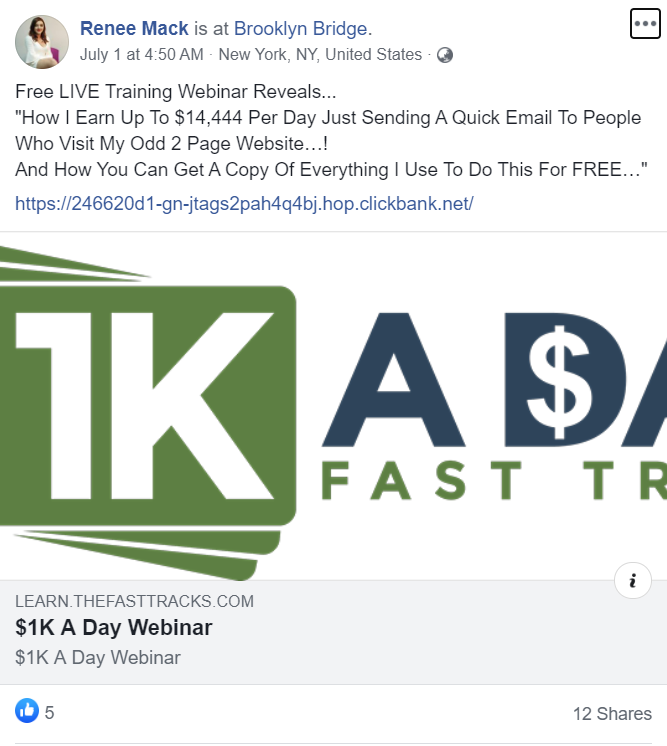
Image via Facebook
b. Email Marketing
Yet another way of driving traffic to your webinar landing page is that of leveraging email newsletters.
This method can come in handy if you already have a few email subscribers in your contact list.
It can be very effective as these people have already shown interest in your brand. As a result, they’ll be more likely to check out your email and webinar landing page. This method helps you capture email leads with ease.
The chances of them attending your webinar are higher too.
How can you use this method to your advantage?
All you have to do is craft a great newsletter about your webinar and come up with an attractive subject line.
This can improve the chances of them checking out your newsletter and clicking on the call-to-action (CTA) button in it.
That’s it.
Send the email to your subscribers and see the traffic on your webinar registration page increase.
Note how InfluencerDB sent an email for their webinar. It’s short and has a CTA button at the bottom. It clearly provides the time and the details of the hosts too.
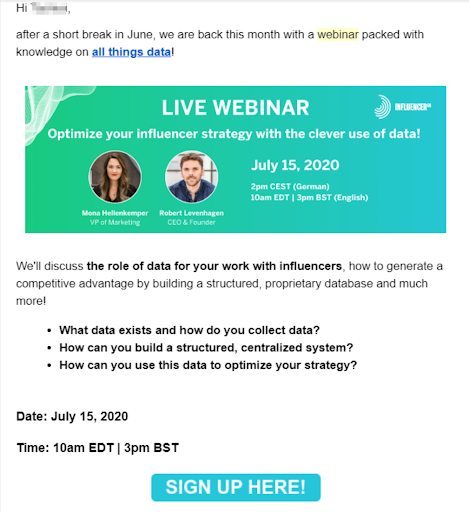
c. Leverage Your Website
If you get good traffic on your website, you should use it to drive traffic to your webinar registration page.
You can add a pop up on your website that asks the visitors to register for the webinar.
Alternatively, you can add a sticky bar at the top or bottom of your website. There, you can add details about your webinar and add a CTA button to drive traffic to the webinar landing page.
Those visitors who’ll be interested in the webinar will click on the CTA button or register for the webinar through the pop up that appears.
However, getting traffic to your landing page is only one part of the game. Your landing page needs to be attractive enough for them to want to register for your webinar.
You should add ample visuals, write stellar landing page copy, and add a registration form. Using FLOW’s landing page builder, you can do all of this in seconds.
It’ll also send automatic reminders to your attendees so that they are reminded about the webinar.
2. Thank People for Registering
One essential step that you might forget is that of thanking people for registering for your webinar. After all, they’ve taken the time to fill out the form and give you their details.
It can help you leave a good impression.
But that’s not all.
You can leverage it to spread the word about your webinar too. That’s why the Thank You page is the third step of the webinar funnel. While many marketers skip this step, you really should create this page.
On this page, you can also add buttons through which the leads can share the webinar with their friends.
As a result, you’ll benefit from greater reach and it can help you drive more registrations too.
You don’t need to overdo it. Keep the Thank You page simple.
Say thanks to your registrants and ask them to share the webinar with their friends.
You can also provide details about the webinar and provide them with the option to add it to their calendars.
PTC has a simple Thank You page. While it doesn’t provide links to share the webinar, it tries to generate engagement on the website by suggesting similar blog posts.
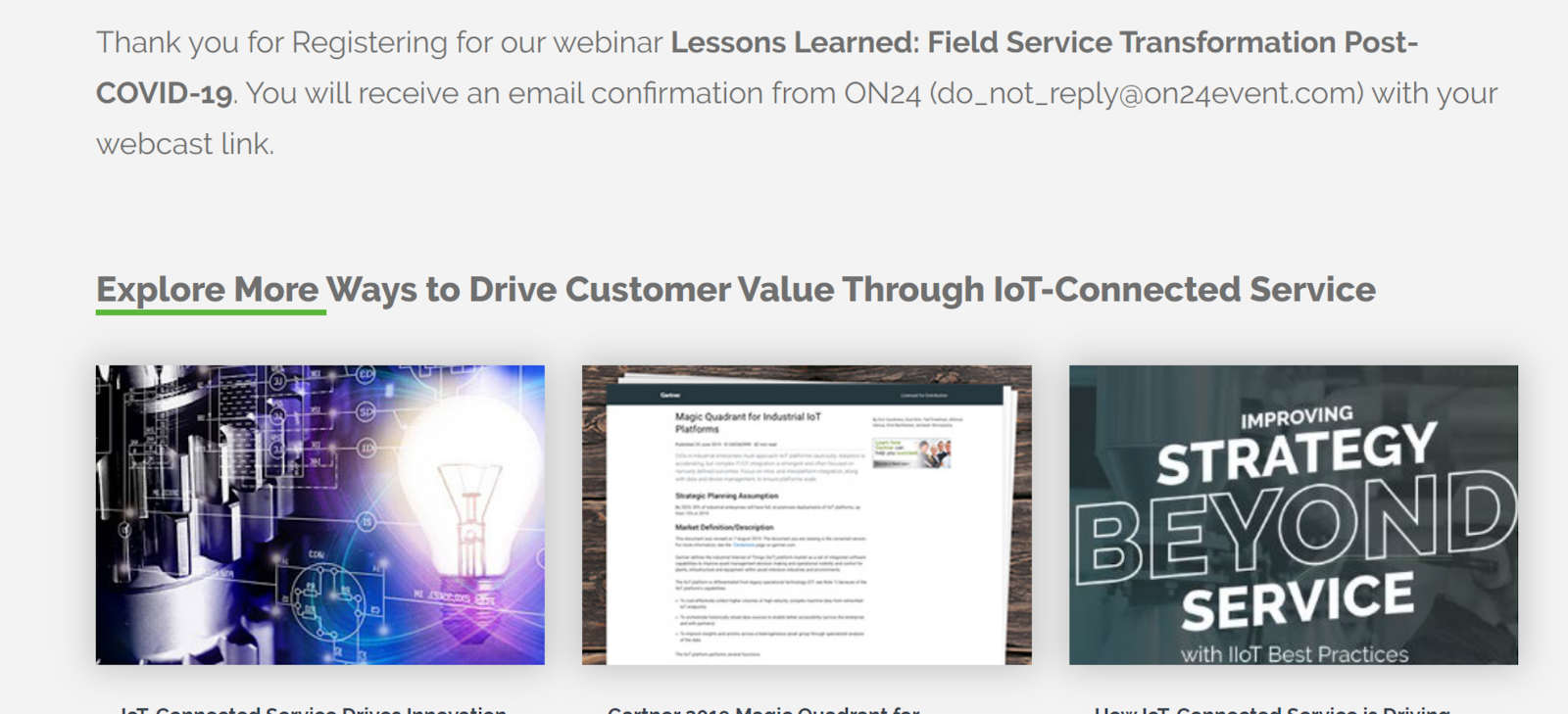
Image via PTC
3. Host a Great Webinar
The next step is one of the most crucial steps of creating a webinar funnel, and that’s hosting the webinar itself. You need to get this step right as it’ll help you drive conversions for your brand.
Make sure that you don’t leave any stone unturned in your webinar.
Provide value to your attendees and solve their problems so that they’ll remain engaged throughout the webinar.
At no moment should your webinar be dull. You should always try to keep it engaging.
How can you do so?
Include lots of examples, provide case studies, and don’t shy away from sharing your own experiences as well.
Make sure you have slides with loads of visuals to hold the attention of your audience.
You should also ensure that your webinar is not overly promotional. It is, of course, necessary to promote your products or services.
However, trying to go for the hard-sell approach won’t work out well. It can put off your attendees.
Instead, you should mention them in a more organic and natural way such that it doesn’t appear outrightly promotional in nature.
You should also share valuable resources with your audience that they can refer to and provide details of other products or services they can use too.
Lastly, try to interact with the attendees as much as possible. Answer their questions and keep the webinar conversational. This can help you build relationships with them.
Using FLOW, you can seamlessly create and host a great webinar. Our Smart Storyboard feature lets you preload every content block before the webinar.
This way, you can load presentations, polls, videos, and more in advance so you won’t hit a snag during the webinar.
You can also provide separate permissions to your presenters for each block to ensure smoother transitions.
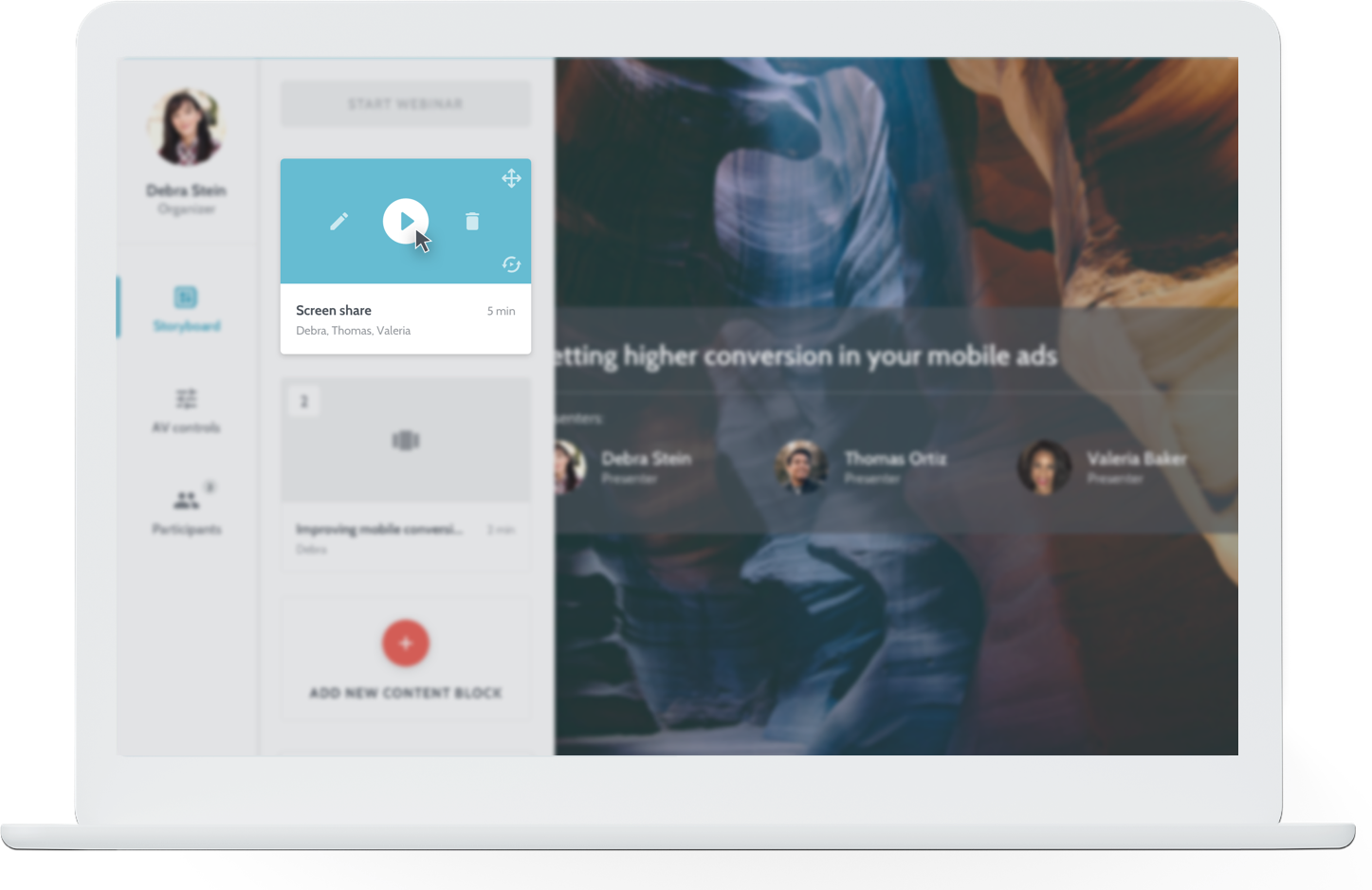
Image via FLOW
4. Create a Stellar On-Demand Webinar
While a live event can be engaging and provides an interactive experience, it’s a one-time show. Your audience can’t revisit the webinar if they want to understand some parts of it again.
This is where on-demand webinars can help your brand. These webinars are pre-recorded and play just like a live webinar. The pre-recorded content can help you deliver a live webinar experience to your attendees whenever they want.
These webinars are great for your webinar funnel.
Why?
Because they give flexibility to your audience. The time for a live webinar is fixed. If someone’s interested in it but isn’t available at that specific time, they may not register for it.
However, with an on-demand webinar, they can listen to it whenever they want, as many times as they want. As a result, you can get more registrations for the webinars.
How can you create an on-demand webinar?
FLOW provides you with the option to create an automated webinar using our Autoflow feature. You can automate your blocks and create a webinar that combines live presentations, polls, and more.
We also provides detailed insights into the webinar statistics so that you can figure out what worked for you and where you can improve.
5. Use a CTA to Drive Conversions
Towards the end of your webinar, you need to add a call-to-action (CTA).
Even though your webinar has been engaging and informative for the attendees, you need to add a CTA to get them to purchase from you.
This is critical to ensure that the maximum number of attendees move from the webinar viewing stage to the buying stage of your webinar funnel.
The best part about webinars is that your CTA doesn’t need to be in the form of a button.
You can get creative with it and craft it such that it can naturally drive your attendees to the product or service page.
The CTA can be spoken and then you can provide a link to the product or service page so that they can complete their purchase.
To improve your conversion rates even further, you should consider providing a discount to your attendees.
If you do so, don’t shy away from stating that the promotion is exclusive for the webinar attendees. This will make them feel special and nudge them to purchase your product or service.
It also helps to add some testimonials to strengthen your case even further.
6. Follow Up with Those Who Didn’t Convert
Once your webinar’s over, you can view detailed statistics related to it using FLOW’s analytics.
There, you can figure out your conversion rate and also note how many people dropped out of the webinar.
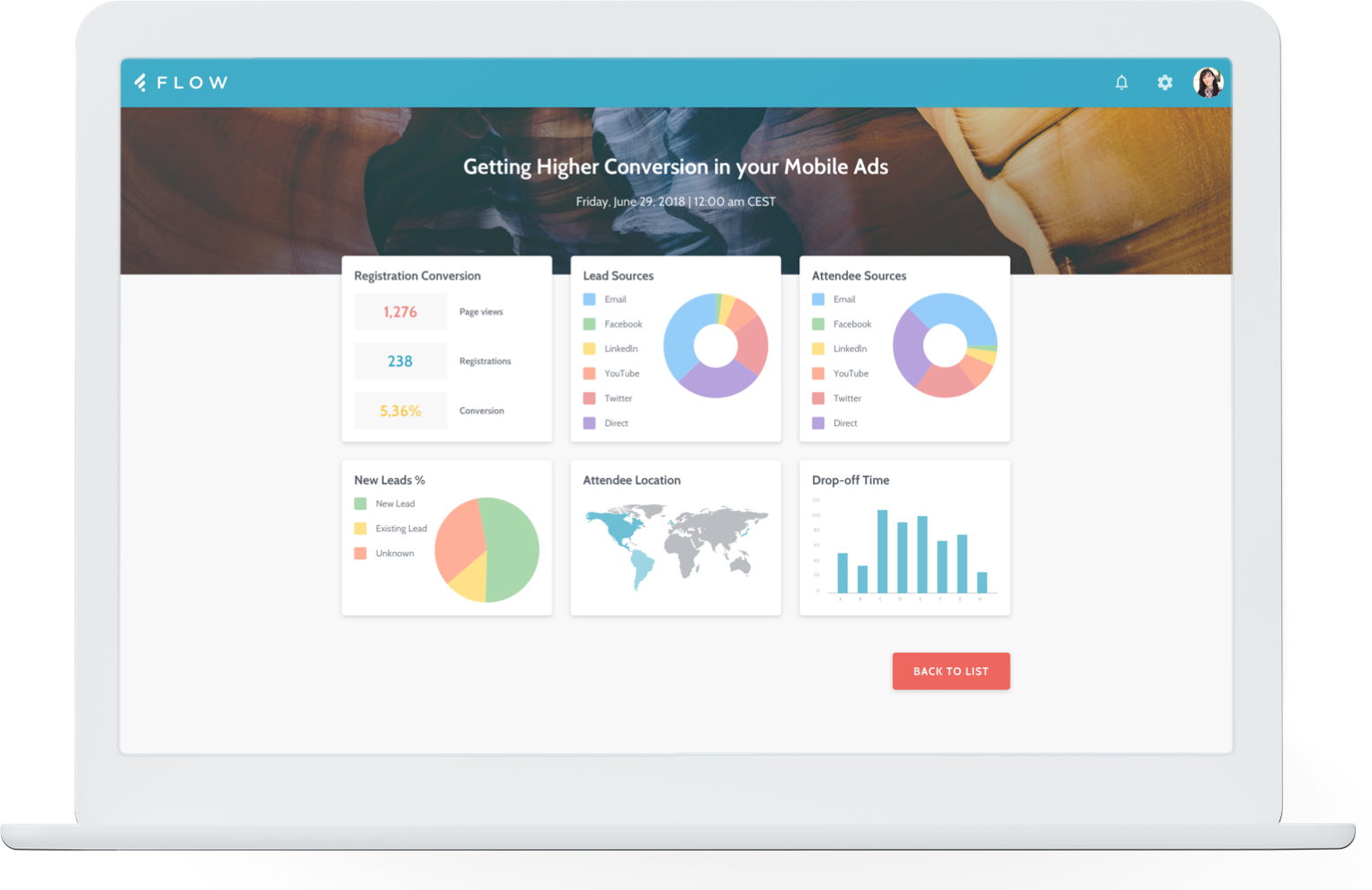
Image via FLOW
To increase your sales from the webinar, you should consider following up with those who didn’t convert at first.
You can send them an email to thank everyone for attending the webinar and for their time. You can provide them with the slides of the webinar or the on-demand webinar as well.
In the email, you can mention that the offer extended to them during the webinar is extended further and they can still purchase your product or service.
You can send out this follow up email multiple times to those who didn’t convert. This can help you convert as many people as possible.
Those who may not have purchased your product or service due to some unforeseen reason may end up completing their purchase and you’ll get a customer, thus completing your webinar funnel.
Final Thoughts
Webinars are great tools for lead generation. If done effectively, they can be used to drive sales as well.
However, designing your webinar funnel well is critical for the success of your webinars. You need to drive quality traffic to a high converting landing page.
After the visitors have registered for the webinar, you should thank them and nudge them to share the webinar with their friends.
It’s also crucial to conduct a stellar webinar that provides valuable information to the attendees and also promotes your products naturally.
You should consider on-demand webinars to reach a wider audience too.
In the end, you should add a CTA that nudges them to purchase your products or services. You should send follow up emails to all those who don’t convert then.
Share the webinar slides or the on-demand webinar with them to get their attention. Doing so a few times can help you convert even more people.
Have any questions related to the creation of your webinar funnel? If so, do let us know in the comments section below.